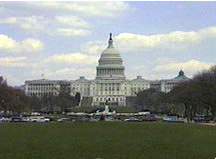Fri, Feb 18, 2011
Rockefeller, Hutchison Say The Bill Will Create Jobs, Make Air
Travel Safer
The full United States Senate passed the FAA Air Transportation
Modernization and Safety Improvement Act Thursday. The bill passed
the Senate by a vote of 87-8.

Senator Rockefeller
“This bill reforms the aviation industry in a way that
will help Americans from all walks of life,” said Commerce
Committee chair John D. (Jay) Rockefeller (D-WV) after the vote.
“The bill will support thousands of jobs, strengthen airline
safety, and modernize America’s outdated air traffic control
system. It offers benefits to both rural airports and large urban
airports. It will lead to a better aviation system for all
Americans and safer flights. Thankfully, we fought off efforts by
some to cut back on rural air service that directly benefits West
Virginia airports. Although we must and will reduce the deficit,
haphazard cuts will compromise the safety and growth of our
aviation system. We can’t ever put safety second. I hope we
can work with the House to get a bill to the President’s desk
quickly.”

Senator Hutchison
“This important legislation takes concrete steps toward
improving our nation’s aviation safety and modernizing our
aging air traffic control system,” said Texas Republican
Senator Kay Bailey Hutchison. “This bill goes a long way to
advance and promote our nation’s air travel system and the
flying public’s trust in its safety.”
The FAA Air Transportation Modernization and Safety Improvement
Act as passed by the Senate would:
- Strengthen the inspection of airline operations.
- Require better safety oversight of foreign repair
stations.
- Require the FAA to develop a plan to improve runway safety by
providing pilots traffic information in the cockpit, and initiate
better processes for tracking and investigating operational
errors.
- Improve safety for helicopter emergency medical service
operations by mandating that the FAA standardize dispatch
procedures, requiring the use of terrain awareness and warning
systems, and making certain flight data and cockpit voice recorders
are on board medical helicopters.

The bill includes several provisions to modernize the
nation’s air transportation system, and to ensure that the
FAA adopts the next generation of air traffic control technology in
a timely and effective manner. The bill would:
- Establish clear deadlines for the adoption of existing Next
Generation Air Transportation System (NextGen) navigation and
surveillance technology. For example, the bill requires the
development of Required Navigation Performance (RNP) and Area
Navigation (RNAV) procedures at the busiest 35 airports by 2014,
and for the entire National Airspace System (NAS) by 2018.
- Direct the FAA to accelerate planned timelines for integrating
Automatic Dependent Surveillance-Broadcast (ADS-B) technology into
the NAS.
- Create an “Air Traffic Control Modernization Oversight
Board” to provide better oversight of FAA’s
modernization programs.
- Establish a “Chief NextGen Officer” position at FAA
to oversee implementation of all NextGen programs, and provide
greater accountability over the modernization process.

Chairman Rockefeller included key provisions in the bill to
strengthen the federal government’s commitment to small
community air service. Those provisions include:
- Improve the Essential Air Service (EAS) program by allowing
communities greater flexibility in attracting desired air service,
including: (1) permitting new financial incentives into contracts
with EAS carriers to encourage better service; (2) allowing
longer-term EAS contracts if such an arrangement is in the public
interest; (3) allowing the development of incentives for large
airlines to code-share on service to small communities; and (4)
requiring large airlines to code-share on EAS flights in up to 10
communities.
- Establish an Office of Rural Aviation within the Department of
Transportation (DOT) to focus on the development of longer-term EAS
contracts.
- Extend a provision that raises the federal share for certain
small airport improvement projects to 95 percent.
The House version of the bill has cleared the Transportation and
Infrastructure Committee, and will next go for markup in the
Committee on Ways and Means. Once a bill is passed by the full
house, the two must be reconciled by a conference committee, which
is where previous versions of the bill have stalled.
More News
Ultrahigh Frequency (UHF) The frequency band between 300 and 3,000 MHz. The bank of radio frequencies used for military air/ground voice communications. In some instances this may >[...]
During The 7 Second Descent, There Was Another TAWS Alert At Which Time The Engine Remained At Full Power On October 24, 2025 at 2115 mountain daylight time, a Cirrus SR22T, N740TS>[...]
From 2009 (YouTube Edition): Educational Organization Aims to Inspire by Sharing Tuskegee Story Founding leader Don Hinz summarized the Red Tail Project’s mission in simple, >[...]
“This feels like an important step since space travel for people with disabilities is still in its very early days... I’m so thankful and hope it inspires a change in m>[...]
Also: New Katanas, Kern County FD Training, IndiGo’s Botched Roster, MGen. Leavitt Named ERAU Dean The Australian Transportation Safety Bureau (ATSB) has wrapped up its inves>[...]
 ANN's Daily Aero-Term (12.19.25): Ultrahigh Frequency (UHF)
ANN's Daily Aero-Term (12.19.25): Ultrahigh Frequency (UHF) NTSB Prelim: Cirrus Design Corp SR22T
NTSB Prelim: Cirrus Design Corp SR22T Classic Aero-TV: The Red Tail Project--Carrying the Torch of the Tuskegee Airmen
Classic Aero-TV: The Red Tail Project--Carrying the Torch of the Tuskegee Airmen Aero-News: Quote of the Day (12.19.25)
Aero-News: Quote of the Day (12.19.25) Airborne 12.17.25: Skydiver Hooks Tail, Cooper Rotax Mount, NTSB v NDAA
Airborne 12.17.25: Skydiver Hooks Tail, Cooper Rotax Mount, NTSB v NDAA






